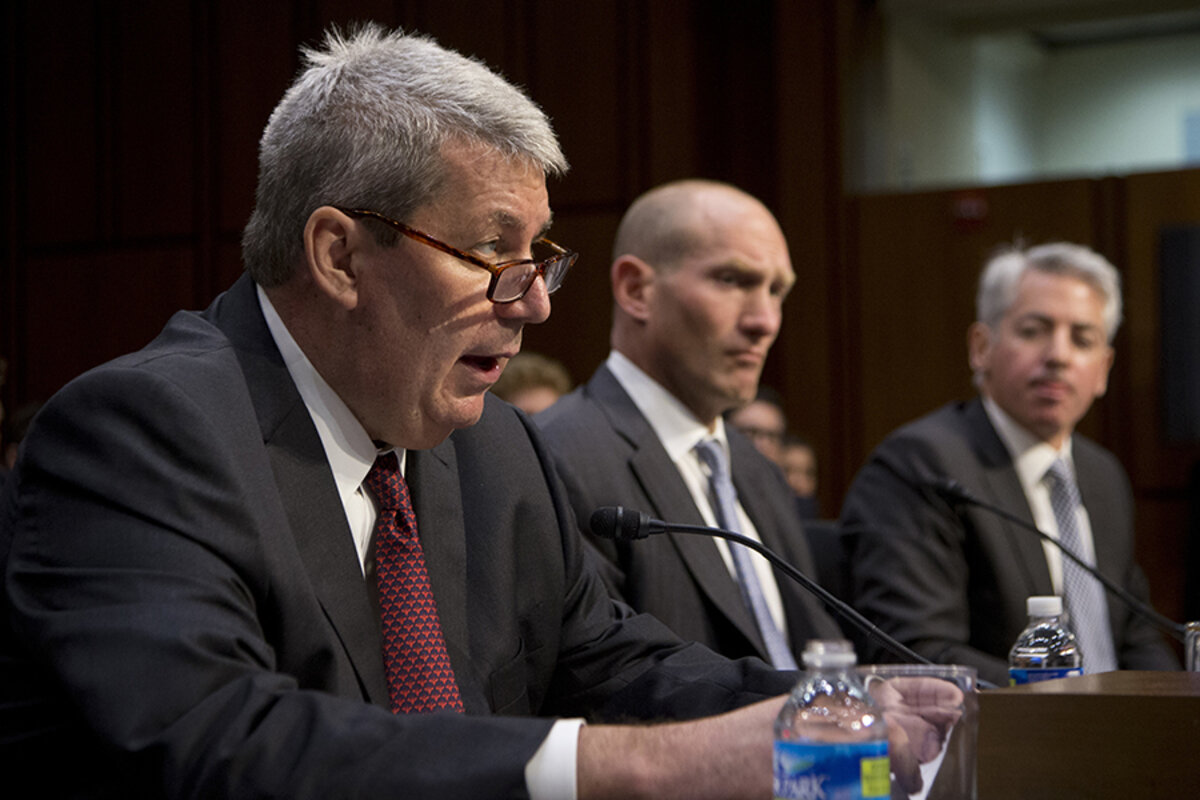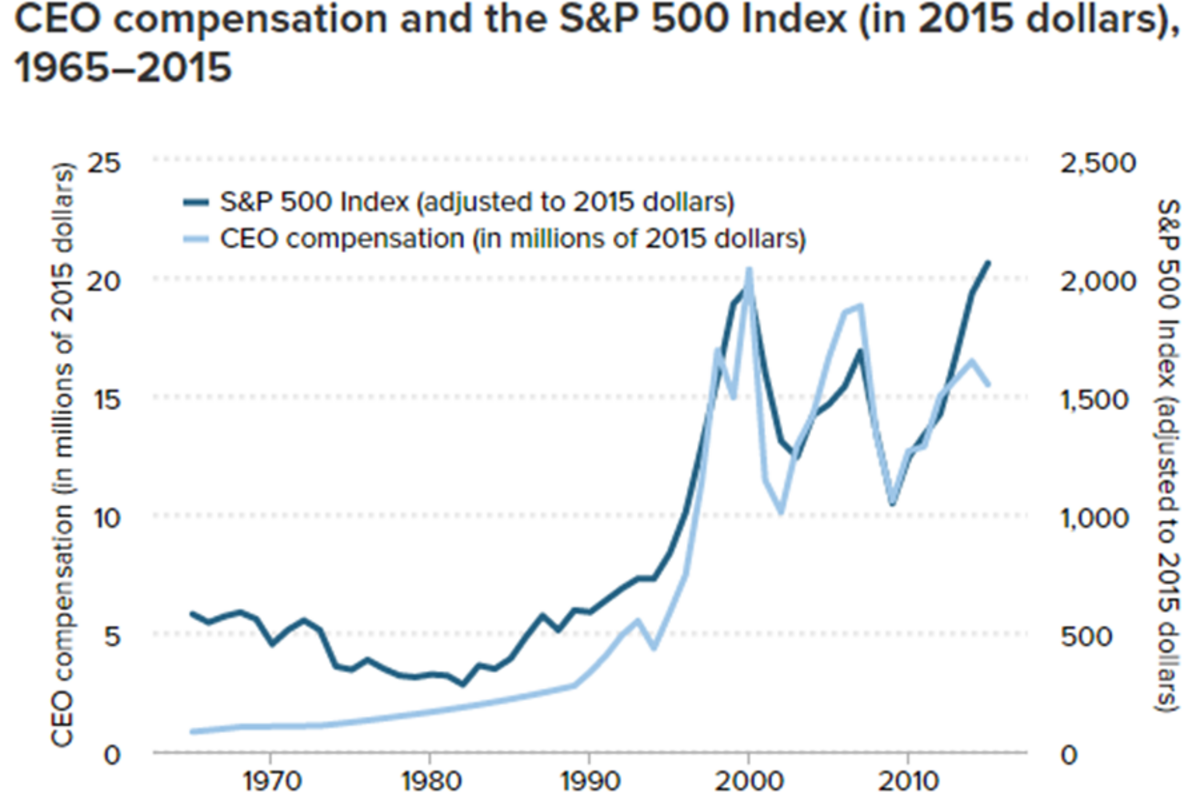CEO pay still high, but no longer a runaway train
Loading...
Seeking to raise profits, the board of Mylan NV two years ago authorized an aggressive bonus program for its top executives if they could meet certain targets. Last year, when they beat those targets, the stock soared â briefly â and chief executive officer Heather Bresch saw her pay rise to $18.9 million, double what she got in 2013.
But one reason profits rose was that the pharmaceutical company doubled the price of its popular EpiPen, used to treat allergic reactions. When consumers started complaining, the stock fell back to earth and the company has scrambled to meet those concerns while scrutiny from Congress ratchets up.
Itâs just another example, critics say, of runaway executive pay, where CEOs boost profits (and their own bottom line) with short-term moves at the expense of their companyâs long-term growth.
But underneath the emerging controversy surrounding Mylan, a broader countertrend is emerging: Executive pay has stopped going up in relation to income pulled in by the average worker. The ratio is still breathtakingly high by any measure. But it is no longer soaring as it did during the 1990s. The change marks a period of relative equilibrium in executive pay and reduces the momentum of an important driver of income inequality.
âPeople say [CEO pay] keeps going up, and thatâs just wrong,â says Steve Kaplan, a professor of entrepreneurship and finance at the University of Chicago's Booth School of Business. Adjusted for inflation, average estimated pay for CEOs has been essentially flat since 2002, according to Professor Kaplanâs figures.
Last year, overall CEO pay actually fell by 15 percent, according to the , a ranking of the CEOs of $1 billion-plus companies that is conducted annually for The New York Times. The AFL-CIO noticed a similar dip.
Today versus 1978
None of this mollifies activists who want the ratio to return to more historical norms. They point out that average CEO pay last year was $15.5 million, 276 times more than what an average nonsupervisory worker would make in the private sector. True, thatâs not as high as during the dot-com bubble of 2000, when CEO pay soared to 376 times the average workerâs income. But itâs nearly 10 times the 30-to-1 ratio that existed in 1978, according to the Economic Policy Institute (EPI), a liberal Washington think tank.
And because so much of CEO pay is tied to the price of the company stock, the ratio could rise again if the stock market soars again.
CEO pay âis high and I think it's going to grow,â says Lawrence Mishel, president of EPI. âWe're on track to reestablish a new high.â
Other forces, however, are pushing in the other direction.
After shareholders owning 55 percent of the stock criticized high executive pay last year at Vertex Pharmaceuticals, the Boston-based biotech firm overhauled its compensation policies and cut CEO Jeff Leidenâs pay by 23 percent.
Thatâs by far the exception rather than the rule. When shareholders get the chance to vote on executive pay, they approve the pay packages more than 98 percent of the time. Whatâs changed is that these so-called âsay on payâ resolutions are now the norm. As of July, nearly two-thirds of the Russell 3000 companies had allowed shareholders to vote on company pay packages this year, , an executive compensation consultancy with offices in Princeton, N.J., and Los Angeles.
The added public attention is one factor that corporations have to take into account when they craft the CEOâs pay package.
Another key change is how they report compensation. Starting next year, publicly traded companies will have to disclose the ratio of their CEO pay to that of their typical worker. That kind of benchmark will give activist investors ammunition if, for example, the ratio goes up while the company falters.
Government is weighing further moves to rein in executive pay. The United States Securities and Exchange Commission (SEC), which implemented the pay-ratio disclosure, is considering new rules that would require executives to give back their bonus pay if their companies subsequently lose money. Some 85 percent of Fortune 500 companies already have such âclawbackâ policies, but boards often unless executive misconduct is involved, according to Pay Governance, another executive pay consultancy. The SEC rules would standardize those policies and leave corporate boards much less discretion to be lenient toward their executive officers.
Will companies rein themselves in?
By themselves, these moves will not do much to bring down CEO compensation, executive pay experts say. But companies themselves may take a second look as evidence mounts that sky-high executive pay is bad for the companies that implement it.Â
It lowers employee morale. âLower-paid CEOs receive the highest approval marks, while the highest-paid CEOs receive the lowest average approval ratings,â according to released last month by jobs and recruiting marketplace Glassdoor in Mill Valley, Calif. (The effect is mitigated if the company has a great corporate culture.)
High CEO pay can also hurt the corporate brand. that companies with a 1000-to-1 pay ratio need to cut the price of their goods and services by half in order to receive the same positive consumer impressions as a firm with a 5-to-1 pay ratio.
High pay also raises company risk. As early as 2005, that companies with high bonuses and option grants (that couldnât be explained by company size or performance) defaulted two to three times more often than companies with average paid CEOs and their downgrade rates were double that of average pay companies.
Of course, corporations want their executives to take some risks to grow the business, which is why they put incentives into pay packages in the first place. The trick is to thread the needle between calculated risk and too much risk.
Some companies are taking steps to limit CEO pay â not because they have to but because they want to. For example, Whole Foods has voluntarily set its CEOâs pay at 19 times its average workerâs pay, a ratio far more typical of the 1960s than today.
So-called B Corporations, mostly private businesses aiming to pursue profits in a socially and environmentally responsible way, take an even stricter approach. More than half have a pay ratio of 5 to 1 or less, says Jay Coen Gilbert, co-founder of B Lab, which certifies the companies. And thatâs the ratio of CEO pay to the lowest-paid worker, not the average one.
What caused the jump
Economists disagree over what caused the big jump in executive pay in the 1990s. Was it mostly market forces or the sway that CEOs have over their corporate boards? How about the growing size of firms?
What is clear is that the pay ratio has changed dramatically over the years. High during the 1930s, it dipped in the 1940s.
âSome portion of the contraction in executive pay in the 1940s can be attributed to a strengthening in the power of labor unions,â writes Dimitris Papanikolaou, a finance professor at  Northwestern Universityâs Kellogg School of Management, in an email citing work by his collaborator Carola Frydman of Boston University.Â
The pair of researchers point to technological change as a big driver of rising CEO pay. One kind of change â workplace training, for example â improves worker productivity so that both workers and the CEO see pay increases. But another kind of technological change, such as R&D that leads to a new product, benefits the company but doesn't directly improve worker performance. That can lead to more bonus pay for the CEO, widening the chasm between executive and average worker pay even more, Dr. Papanikolaou says.
At the end of the day, corporations have to attract the best candidates who can find those technology breakthroughs and implement them. And a competitive pay package is a big lure. If efforts to curb CEO pay get too draconian, the best candidates may instead flock to privately held companies, where the scrutiny is far less than it is for publicly traded companies, Mr. Kaplan warns. âYou will get an increased movement of talent away from public companies to private equity funded companies and other private companies.â






